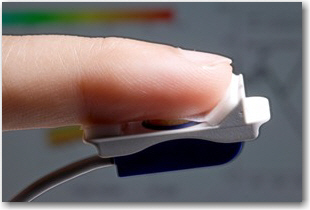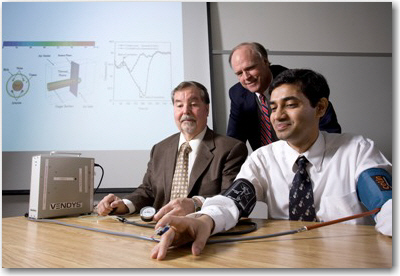Two University of Houston professors are working to help keep your heart beating stronger and longer simply by monitoring the temperature of your fingertip.
VENDYS, a device mechanical engineering professors Stanley Kleis and Ralph Metcalfe helped develop, is allowing doctors to monitor how changes in blood flow affect finger temperature to measure an individual’s risk for cardiovascular disease (CVD).
In a paper recently published in the Journal of Biomechanical Engineering, Kleis, Metcalfe and UH graduate student Mohammad Akhtar detail how a mathematical model is assisting them to better understand the real-life physics behind VENDYS. Their hope is that the model will aid them in further perfecting the non-invasive device, which is manufactured by Endothelix Inc. and already in use across the country as an early test for CVD. For the last seven years, Metcalfe has worked alongside Endothelix’s founder, Dr. Morteza Naghavi, to bring the device from idea to application.
“This is the first paper on this topic, really, in biomedical engineering literature,” said Metcalfe. “VENDYS is helping move us from a risk assessment to an actual non-invasive measurement focused on a specific individual. This model will be essential in helping us make VENDYS a more accurate, cost-effective early detection method.”
Guided by the mathematical model, these researchers are examining how factors such as room temperature or a recent meal influence test results. By understanding their impact, they hope to be able to determine the conditions necessary to get the most accurate final results.
VENDYS has been in use since the U.S. Food and Drug Administration approved it for commercial sale in 2007. Less invasive and more cost effective than many traditional methods for CVD screening, including blood tests, CAT scans and MRIs, the device consists of a blood pressure cuff and detector that are hooked up to a computer equipped with specialized software.
Not much larger than a quarter, the detector is placed on the fingertip, while a blood pressure cuff is wrapped around a patient’s arm. The cuff is inflated for a period of two to five minutes as blood flow to the hand decreases and the finger temperature drops due to the absence of warm circulating blood. Once the cuff is released, blood flow rushes into the forearm and hand. A sensor in the detector, attached to the fingertip, records data on how fast and completely temperature in the finger rebounds. In all, the test takes no more than 15 minutes. Unlike most other methods, the results paint a picture of an individual’s vascular health.
“The speed and magnitude of temperature recovery is a measure of vascular reactivity,” Kleis said. “The greater the rebound, the more reactive and healthy the artery. We helped quantify this with our models. A lower or weaker return of temperature signifies a problem that should prompt consultation with a cardiologist.”
 “Cardiovascular disease is the most lethal disease in the United States and other developed countries, but one important aspect of it is that if it’s caught at an early stage, then it’s treatable,” Metcalfe said. “You can actually prevent its progression by modifying your lifestyle to include a more healthy diet and exercise. In some cases, you can actually reverse it.”
“Cardiovascular disease is the most lethal disease in the United States and other developed countries, but one important aspect of it is that if it’s caught at an early stage, then it’s treatable,” Metcalfe said. “You can actually prevent its progression by modifying your lifestyle to include a more healthy diet and exercise. In some cases, you can actually reverse it.”
VENDYS is designed to be complimentary to other cardiovascular tests, but researchers are hopeful it can be more widely used to regularly monitor cardiovascular fitness. More specifically, for those known to be affected by the disease who are trying to stop its further progression through things such as diet and exercise, it could be a risk-free indicator of how they are doing. Additionally, Endothelix is working on ways to make the device portable.
“You don’t want to get an X-ray scan every month – that involves too much radiation exposure,” Metcalfe said. “But something like this could be used to help track progress and see if you are indeed improving. This kind of feedback could really be valuable.”
NOTE TO JOURNALISTS: High-resolution photos of the researchers and the fingertip device are available to media by contacting Lisa Merkl.
About the University of Houston
The University of Houston is a comprehensive national research institution serving the globally competitive Houston and Gulf Coast Region by providing world-class faculty, experiential learning and strategic industry partnerships. UH serves 37,000 students in the nation’s fourth-largest city in the most ethnically and culturally diverse region in the country.
About the Cullen College of Engineering
The Cullen College of Engineering at UH has played a vitally important role in educating engineers in Texas. Taught by innovative faculty, eight of whom are in the National Academy of Engineering, the college offers degree programs in biomedical, chemical, civil, computer, electrical, environmental, industrial, mechanical and petroleum engineering, as well as specialty programs in materials, aerospace, and computer and systems engineering.
For more information about UH, visit the university’s Newsroom at http://www.uh.edu/news-events/.
To receive UH science news via e-mail, visit http://www.uh.edu/news-events/mailing-lists/sciencelistserv/index.php.
For additional news alerts about UH, follow us on Facebook and Twitter.
VENDYS, a device mechanical engineering professors Stanley Kleis and Ralph Metcalfe helped develop, is allowing doctors to monitor how changes in blood flow affect finger temperature to measure an individual’s risk for cardiovascular disease (CVD).

In a paper recently published in the Journal of Biomechanical Engineering, Kleis, Metcalfe and UH graduate student Mohammad Akhtar detail how a mathematical model is assisting them to better understand the real-life physics behind VENDYS. Their hope is that the model will aid them in further perfecting the non-invasive device, which is manufactured by Endothelix Inc. and already in use across the country as an early test for CVD. For the last seven years, Metcalfe has worked alongside Endothelix’s founder, Dr. Morteza Naghavi, to bring the device from idea to application.
“This is the first paper on this topic, really, in biomedical engineering literature,” said Metcalfe. “VENDYS is helping move us from a risk assessment to an actual non-invasive measurement focused on a specific individual. This model will be essential in helping us make VENDYS a more accurate, cost-effective early detection method.”
Guided by the mathematical model, these researchers are examining how factors such as room temperature or a recent meal influence test results. By understanding their impact, they hope to be able to determine the conditions necessary to get the most accurate final results.
VENDYS has been in use since the U.S. Food and Drug Administration approved it for commercial sale in 2007. Less invasive and more cost effective than many traditional methods for CVD screening, including blood tests, CAT scans and MRIs, the device consists of a blood pressure cuff and detector that are hooked up to a computer equipped with specialized software.
Not much larger than a quarter, the detector is placed on the fingertip, while a blood pressure cuff is wrapped around a patient’s arm. The cuff is inflated for a period of two to five minutes as blood flow to the hand decreases and the finger temperature drops due to the absence of warm circulating blood. Once the cuff is released, blood flow rushes into the forearm and hand. A sensor in the detector, attached to the fingertip, records data on how fast and completely temperature in the finger rebounds. In all, the test takes no more than 15 minutes. Unlike most other methods, the results paint a picture of an individual’s vascular health.
“The speed and magnitude of temperature recovery is a measure of vascular reactivity,” Kleis said. “The greater the rebound, the more reactive and healthy the artery. We helped quantify this with our models. A lower or weaker return of temperature signifies a problem that should prompt consultation with a cardiologist.”
 “Cardiovascular disease is the most lethal disease in the United States and other developed countries, but one important aspect of it is that if it’s caught at an early stage, then it’s treatable,” Metcalfe said. “You can actually prevent its progression by modifying your lifestyle to include a more healthy diet and exercise. In some cases, you can actually reverse it.”
“Cardiovascular disease is the most lethal disease in the United States and other developed countries, but one important aspect of it is that if it’s caught at an early stage, then it’s treatable,” Metcalfe said. “You can actually prevent its progression by modifying your lifestyle to include a more healthy diet and exercise. In some cases, you can actually reverse it.” VENDYS is designed to be complimentary to other cardiovascular tests, but researchers are hopeful it can be more widely used to regularly monitor cardiovascular fitness. More specifically, for those known to be affected by the disease who are trying to stop its further progression through things such as diet and exercise, it could be a risk-free indicator of how they are doing. Additionally, Endothelix is working on ways to make the device portable.
“You don’t want to get an X-ray scan every month – that involves too much radiation exposure,” Metcalfe said. “But something like this could be used to help track progress and see if you are indeed improving. This kind of feedback could really be valuable.”
###
NOTE TO JOURNALISTS: High-resolution photos of the researchers and the fingertip device are available to media by contacting Lisa Merkl.
About the University of Houston
The University of Houston is a comprehensive national research institution serving the globally competitive Houston and Gulf Coast Region by providing world-class faculty, experiential learning and strategic industry partnerships. UH serves 37,000 students in the nation’s fourth-largest city in the most ethnically and culturally diverse region in the country.
About the Cullen College of Engineering
The Cullen College of Engineering at UH has played a vitally important role in educating engineers in Texas. Taught by innovative faculty, eight of whom are in the National Academy of Engineering, the college offers degree programs in biomedical, chemical, civil, computer, electrical, environmental, industrial, mechanical and petroleum engineering, as well as specialty programs in materials, aerospace, and computer and systems engineering.
For more information about UH, visit the university’s Newsroom at http://www.uh.edu/news-events/.
To receive UH science news via e-mail, visit http://www.uh.edu/news-events/mailing-lists/sciencelistserv/index.php.
For additional news alerts about UH, follow us on Facebook and Twitter.